Knee Clicking
Knee clicking refers to the audible sound or sensation experienced when bending or straightening the knee joint. This phenomenon is typically characterized by clicking, popping, or cracking noise that occurs during movement, often without associated pain or discomfort.
Knee clicking can result from various factors, including the release of gas bubbles within the joint, movement of tendons or ligaments, irregularities in the joint surfaces, or underlying conditions such as osteoarthritis or meniscal tears.
Introduction
Knee clicking is a common phenomenon experienced by many individuals, often accompanied by a sound or sensation when bending or straightening the knee joint. While it may be unsettling, in most cases, knee clicking is harmless and does not indicate a serious underlying condition. However, understanding its causes, symptoms, and when to seek medical attention is important for maintaining optimal knee health.
There can be no pain at all or there might be pain along with clicking in the knees. A doctor’s examination is highly recommended as soon as possible if your knee is clicking with pain. Even if you don’t have any knee discomfort but are experiencing knee clicking, you should still get checked out because knee clicking with pain could develop at some point. Fortunately, the majority of knee-clicking causes are treatable and usually innocuous.
When you walk, move upstairs, or bend your knees, you might hear occasional snaps, pops, and crackles associated with knee clicking. This cracking sound is known by doctors as crepitus. Extreme knee pain is a common occurrence for patients.
Although there are numerous other reasons why this happens, osteoarthritis is one of them. Knee noises are usually not a cause for concern. But if you have pain as well, you might want to think about having a medical professional examine your knees.
Knee crepitus is not the same as lung crepitus or cracking, which could be a sign of a respiratory condition.
Gas Bubbles: Little nitrogen-filled air bubbles can occasionally accumulate in the fluid inside your joints. During joint movement, these bubbles burst, producing a sound.
Why is My Knee Clicking?
Walking or stair climbing might cause a clicking sound in your knee, which can be unsettling. There are a few reasons why this is happening, and depending on whether you are also suffering any other symptoms, you may or may not need to take this seriously. It might be time to have your knee analyzed if you find that it is clicking more frequently and you are also experiencing any of the following symptoms:
- Knee Pain
- Limited range of motion.
- Swelling.
- Locking.
Do your knees click, and is that a cause for concern?
A peculiar clicking sound made when stretching the joint is one of the most common complaints people have about their knees. These clicking noises coming from the knee might be caused by anything from minor adjustments in joint pressure to arthritis and kneecap use. These sounds are rarely a cause for concern about declining health in moderate situations (that is when the clicking sound is uncommon and unrelated to pain and edema).
You should, however, seek emergency care from a licensed physiotherapist clinic like Southgate Physio in North London, UK, if the clicky noises are excruciating and persistent. To determine the underlying reason for the clicking noises and, if necessary, recommend a remedial treatment, our specialists will employ evidence-based assessment instruments.
Causes Of Knee Clicking
If you hear a clicking sound in your knee, it might be any of the many different problems.
You must first determine whether the popping or cracking causes any discomfort. The popping or cracking is usually not a serious problem if you are not in pain. The reasons for knee clicking are as follows:
Mechanical Popping
A popping sensation experienced by patients is known as a “mechanical symptom.” When the knee bends back and forth, it could seem as though something is caught inside and popping.
Usually, this kind of popping sound indicates a meniscus tear or a loose piece of cartilage inside the joint. A web of connective tissues called fibrocartilage surrounds and cushions the patella, the kneecap. A painful snag in the knee may result from meniscal tears or loose cartilage. This could produce a noticeable “pop.”
Deeper tissue damage lacks the blood arteries required to facilitate the healing process, but certain meniscus tears can mend on their own. Trimming and healing the rip might need arthroscopic debridement.
Crepitus
The crushing sensation felt when bending and straightening the knee is known medically as crepitus. Patients may get crepitus if their cartilage is inflamed.
This symptom is a symptom of an underlying illness called chondromalacia, or injury or loss of cartilage. Furthermore, people who have cartilage wear, such as those with knee arthritis, may also exhibit symptoms of this illness.
Crepitus is a more enduring problem than mechanical popping, which has the appearance of something becoming stuck in the knee.
Generally speaking, crepitus is sensed more than heard. By sitting on a table edge and bending one leg, you can check for crepitus. Next, extend your knee softly and drop it while keeping your palm on the front of your knee. When you have crepitus, you can experience a crushing sensation beneath your palm.
Tendon Snapping
When the knee is bent, swelling in the tendons around it may result in the tendons snagging on the knee. The most common type is tendinitis in the iliotibial (IT) band.
This tendon is called the iliotibial band, and it runs from your hip to just below your knee. As the knee bends back and forth, an enlarged or inflamed band may become stuck on the end of the thigh bone.
The way that this popping occurs is somewhat beneath the skin, which sets it apart from mechanical popping. You may be able to feel the issue if you place your palm on the injured tendon and move your knee.
Surgery for Knee clicking
The knees may become noisier following surgery. When a joint replacement is performed, this may have to do with the characteristics of the newly created joint.
Although the noises were frequently always there, people become more conscious of them after surgery since they are now more aware of their environment.
Three-year research with almost 5,000 patients found that the presence of crepitus after knee replacement did not impact either the long-term prognosis or the quality of life.
Arthritis
While osteoarthritis can affect anyone at any age, those over 50 are the most commonly affected. This type of arthritis is known as “wear and tear” arthritis because it usually affects the knees and other joints that are used frequently.
Osteoarthritis is caused by the deterioration of joint cartilage brought on by metabolic changes and mechanical stress. For instance, when it becomes inflamed, the joint may crack or crunch. Pitting noises along with pain could be a sign of osteoarthritis.
Air bubbles
Soft tissue allows air to leak into the synovial fluid of the joint, creating tiny bubbles that give popping sounds.
Bubbles can rupture or crack when someone bends or extends their knees. Even while that seems frightening, there’s usually nothing to be concerned about.
The cause of knee clicking could be a knee injury.
An underlying condition could stem, for instance, from lesions or tissue damage. This can call for medical attention.
Scar tissue, a torn meniscus, or a tendon sliding across a projecting bone in the joint can all be the cause of a knee that snaps or catches feeling.
Osteoarthritis (OA), a runner’s knee, patellofemoral pain syndrome (PFS), or a rupture in cartilage or another soft tissue may result in pain or swelling. In certain cases, medical care may be necessary. Now let’s examine more closely them.
What are the symptoms of knee clicking?
Though individual symptoms may differ, knee clicking frequently manifests as:
- Clicking or Popping Sound: Audible pops or clicks that sound as you bend or extend your knee. This sound may or may not be accompanied by related feelings.
- Sensation of Clicking: There could not be any sound, but for some people, there could be a clicking sensation in their knee joints. This feeling can be faint or very apparent.
- Pain or Discomfort: Even though clicking by itself usually doesn’t hurt, it could if there’s an underlying problem like inflammation or cartilage damage. The level of pain varies and it can happen before, during, or after movement.
- Swelling: There are situations where edema around the knee joint occurs together with knee clicking. Depending on the underlying reason, this swelling could be more extensive or localized.
- Limited Range of Motion: There could be a correlation between clicking in the knee joint and a restricted joint range. One possible way to describe this might be stiffness or trouble bending or fully straightening the knee.
- Instability: Some individuals may experience a sense of instability or weakness in the knee joint, particularly if the clicking is related to issues such as ligament damage or joint laxity.
- Catching or Locking Sensation: In more severe cases, knee clicking may be associated with a sensation of the knee catching or locking during movement. This could indicate a mechanical issue within the joint that requires attention.
It’s important to note that while knee clicking is common and often benign, persistent or worsening symptoms, especially those accompanied by pain, swelling, or instability, should be evaluated by a medical expert to identify the underlying reason and the best course of action.
What is the Clicking Sound in the Knees?
Medically speaking, the clicking sound in the knees is called crepitus, and it happens a lot. This sound typically happens when microscopic nitrogen bubbles in the synovial fluid in a joint rupture during motion (this phenomenon is known as “cavitation”). When the joint is moved beyond its intended range, a loud and audible sound is produced. Contrary to common belief, it is not the sound of “bones rubbing together.”
However, there are other circumstances in which you might hear a noise in your knees that might worry you. Should you observe any of these, you ought to speak with a physiotherapist right away:
Osteoarthritis
The inflammation and pain in your body’s joints, known as osteoarthritis, typically strike adults over 50. Wear and tear in the cartilage typically occurs in the joints that support the body’s weight, such as the knees, due to biochemical alterations and mechanical strain. Osteoarthritis with early onset may be indicated by crepitus accompanied by discomfort and edema. At Southgate Physio, we offer comprehensive treatment and pain control for pain and swelling related to arthritis. Speak with one of our certified specialists to learn more about how we assist individuals in managing their arthritis.
Runner’s Knee
A painful overuse ailment, iliotibial band syndrome (commonly known as runner’s knee) is marked by excruciating pain in the front of the knee. It often results from the iliotibial band flicking over the lateral condyle bone, which might be caused by a structural problem. A knee that gets increasingly painful is the most typical sign of a runner’s knee. Avoid overusing your leg muscles till the pain goes away as a treatment for this problem.
Baker’s Cyst
A clicking sound at the back of the knee is indicative of Baker’s cyst. The cause of this disease is a benign cyst, which is a sac filled with fluid, flicking against the medial and hamstring tendons. The swelling will go down on its own, so there is normally no pain and no risk. But, you should see a qualified physiotherapist right once if you have pain when moving and walking.
When anything clicks on your knees, most of the time there’s nothing to be concerned about. However, contact Southgate Physio’s specialists right away if you continue to have discomfort and swelling in addition to the clicking sound.
What the clicking is not?
A common concern among our patients is that the clicking sounds might be the result of bones rubbing against one another and damaging the joints. It’s just not true as stated. Knees click because they are complex, moving parts that move and glide next to one another when you bend and straighten them, as you would when climbing or descending stairs, for example.
Some more arguments against worrying about your clicking knees.
Remarkably, the majority of knee problems we observe in clinics don’t click or clunk! Five reasons you shouldn’t be concerned about your clicking knees:
- There’s no proof that it will get worse with age.
- It’s not proven to “wear out your joint” and result in osteoarthritis (OA).
- You probably won’t be able to stop doing the things you enjoy doing, like cycling, hiking, jogging, squatting, or gardening, with painless clicking!..
- There is no relationship between pain thresholds and the volume or quantity of clicking.
- There’s no reason to believe it will get any worse. It does not indicate pain!
A large number of our physiotherapists have additional training in musculoskeletal sonography. This means that as part of their clinical evaluation, they look inside the body to evaluate the joint and soft tissue structures like ligaments and tendons that surround it using diagnostic ultrasound.
An example of a “dynamic” imaging method is diagnostic ultrasound. In contrast to static imaging methods like MRIs and X-rays, ultrasounds evaluate the structures while the patient performs a particular movement that mimics the “click.” Because of this, it’s the ideal examination to precisely pinpoint the structures that are “clicking” and the precise source of your discomfort.
When is it appropriate for me to seek medical attention?
Your knee clicks and catches. It’s important to visit your doctor for an examination and a definitive diagnosis if you suffer clicking and catching and it’s followed by swelling, intense pain, or both. Furthermore, if your knee swells after an injury and there’s a pop, it may indicate that damage has occurred. Your injuries may be to your meniscus or articular cartilage, or they may be to your anterior, posterior, or medial collateral ligaments.
It’s generally safe to assume that if you have knee clicking and catching but no discomfort or swelling, then it’s probably normal. To prevent more harm to the joint, get in touch with your doctor if you experience discomfort, instability, or swelling. Naturally, for your peace of mind, you should still think about visiting a knee specialist if you’re concerned even in the absence of pain or swelling.
Over the next few weeks, repeat these stretches and assess your progress. In the next few days, you might notice that your muscles are more elastic or have a greater range of motion, which will improve your squat. Your body may be changing, so some meals can aid with inflammation if you are feeling mild soreness in your routine.
Treatment Options
More is happening than what an X-ray can show you. Pain and, eventually, any clicking you may be feeling in your knee will go down if chronic inflammation is decreased and knee stability is improved. The soft tissue and supporting structures surrounding a joint play a critical role in maintaining long-term stability and structure, which should be considered when selecting a course of treatment.
There are numerous non-surgical options to take into account.
- Dextrose prolotherapy is the first-line regenerative medicine for knee discomfort, such as mild to moderate patellofemoral osteoarthritis. It can aid with discomfort and instability brought on by hypermobility and long-term instability in the knee joint and knee cap.
- Somewhat advanced knee osteoarthritis can potentially benefit from platelet-rich plasma.
- The more moderate to advanced patellofemoral and knee osteoarthritis stages can also benefit from bone marrow-derived stem cells.
With these kinds of therapy, one can typically anticipate pain alleviation, functional improvement, and a return to a good standard of living. It’s crucial to remember that these treatments might not always result in observable advancements in imaging tests like MRIs, ultrasounds, and X-rays. But these therapies can certainly make a big difference if your goals are to live a better lifestyle and feel better about yourself.
Knee pops and crackles are not uncommon, especially when bending and extending the knee repeatedly or while kneeling on the ground.
If cephalalgia is not painful, it is rarely an issue.
Physician specialists assess the patient to determine whether arthritis or another ailment is the source of the patient’s knee crepitus and additional symptoms.
An excellent alternative treatment for ailments connected to the knee and hamstrings is physical therapy.
Furthermore, appropriate physiotherapy and sports medicine can effectively address anterior cruciate ligament sports injuries.
Prolotherapy
The clicking-causing structures in and around the knee have a limited blood supply, which makes it difficult for them to heal on their own. These structures heal because of the nutrition and oxygen found in our blood flow.
By directly injecting a regeneration solution into these structures, prolotherapy lowers the clicking by giving the body the resources it needs to mend and heal.
Given that the treatment targets the root source of the problem, it is regarded as a long-term fix.
Physical therapy
Physiotherapy can be an effective treatment option for addressing knee clicking, especially when it’s related to biomechanical issues, muscle imbalances, or minor structural problems. Here are some common physiotherapy treatments for knee clicking:
- Exercise Prescription: Physiotherapists often prescribe specific exercises to strengthen the muscles around the knee joint, including the quadriceps, hamstrings, and calf muscles. Strengthening these muscles can help improve knee stability and reduce abnormal movement patterns that may contribute to clicking.
- Stretching and Flexibility Exercises: Tight muscles around the knee joint can contribute to abnormal biomechanics and clicking. Physiotherapists may recommend stretching exercises to improve flexibility in muscles such as the quadriceps, hamstrings, and iliotibial band (ITB). This can help alleviate tension and reduce stress on the knee joint.
- Manual Therapy: Hands-on techniques such as joint mobilizations and soft tissue massage may be used by physiotherapists to improve joint mobility, reduce muscle tightness, and restore normal movement patterns in the knee joint.
- Biomechanical Assessment and Correction: Physiotherapists can perform a thorough biomechanical assessment to identify any underlying issues with gait, posture, or movement patterns that may contribute to knee clicking. They can then provide corrective strategies and techniques to address these issues and improve overall knee mechanics.
- Patellar Taping or Bracing: In cases where knee clicking is related to patellar tracking issues, physiotherapists may use techniques such as patellar taping or bracing to help realign the patella and reduce friction between the patella and femur during movement.
- Education and Activity Modification: Physiotherapists can educate patients about proper knee mechanics, posture, and movement patterns to minimize stress on the knee joint and reduce the risk of clicking. They may also guide activity modification and lifestyle changes to prevent aggravation of symptoms.
- Modalities: In some cases, modalities such as ultrasound, electrical stimulation, or cold therapy may be used by physiotherapists to reduce pain and inflammation in the knee joint, especially during the initial stages of treatment.
- Functional Rehabilitation: As symptoms improve, physiotherapists may progress treatment to include functional exercises and activities that mimic real-life movements to help patients regain strength, stability, and confidence in using their knee joints.
It’s important for individuals with knee clicking to consult with a qualified physiotherapist for a thorough assessment and personalized treatment plan tailored to their specific needs and underlying causes of knee clicking. Compliance with the prescribed exercises and interventions is crucial for achieving optimal outcomes and preventing the recurrence of symptoms.
How To Fix A Clicking Knee
Both yes and no. First, there’s no way to prevent gas and the occasional tendon catching. They are only a necessary component of having a working joint. Second, treating the underlying reason will happily result in less clicking when it comes to knee clicking caused by an accident or medical condition. To do that, follow these steps:
BRACE
For the best support for an injured knee, use a knee brace. However, you must make sure the brace is made for your specific injury type, is medical grade, and fits you precisely.
Our recommendation for Jumper’s Knee is the GenuTrain.The medical-grade compression knit used in the brace helps to increase circulation and contract the muscles, giving your wounded tendon the support and nourishment it needs to heal. Additionally, a sewn-in patella pad relieves pressure and inflammation on the patellar tendon.
The GenuTrain P3 is the best choice for treating ITBS and patellofemoral dysfunction. To ease the band and prevent it from pulling on and clicking against the joint, it has an ITB pad incorporated into it. Additionally, it has a unique patella pad and cover that are intended to stabilize and improve the tracking of the kneecap.
In addition, meniscus injury and osteoarthritis in the knee:
If your case is not severe, use GenuTrain A3. Adduction and abduction, or the inward and outward tilt of the knee, are controlled by the compression knit in conjunction with a massaging pad to reduce pain and stiffness and release pressure on the injured cartilage.
If it’s moderate, use GenuTrain OA. To offload the joint, you’ll need to use the compression knit in conjunction with external supports.
Also recommended for meniscus damage or severe osteoarthritis symptoms is SecuTec OA. It provides the finest support for severe cartilage damage since it is a rigid, hinged knee brace.
Releases
The Patellofemoral joint may get compressed due to tightness in the muscles that immediately attach to the patella. This may make the patella more likely to rub against the femur.
Front of thigh
(Target muscles: Rectus Femoris, Vastus Lateralis/Medialis/Intermedius)
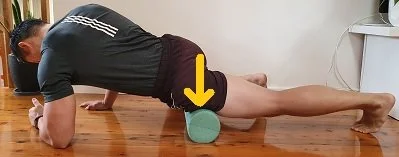
Instructions:
- A foam roller should be placed on top of the muscles in your front thighs.
- Put as much pressure on the object as you are comfortable with.
- Be careful to cover the thigh all the way around.
- For two minutes, keep going, pausing in any location where you feel more tightness.
- Note: Pay attention to the tight regions!
Above knee cap
(Target muscles: Distal Quadriceps)
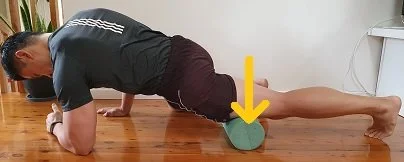
Instructions:
- Position the region just above the kneecap atop a foam roller.
- Put as much pressure on the object as you are comfortable with.
- For one minute, keep going.
Under knee cap
(Target muscle: Patella tendon)
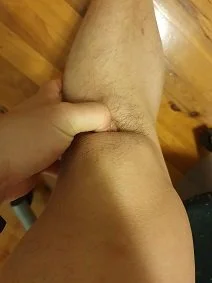
Instructions:
- Stretch your leg out in front of you while seated in a chair.
- Maintain total relaxation in the leg.
- Push and massage into the Patella tendon with the tips of your thumbs.
- Keep going for a minute.
Side glides
(Target area: Retinaculum/Fascia)
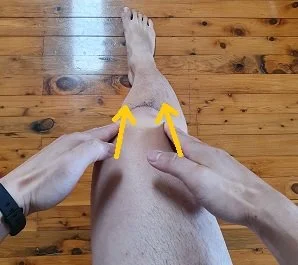
Instructions:
- Stretch your leg out in front of you while seated in a chair.
- Maintain total relaxation in the leg.
- With the tips of your fingers, gently press and move the skin down the sides of your knees.
- Five times over, repeat.
Front/side of the shin
(Tibialis Anterior, Extensor Digitorum, and Extensor Hallucis Longus are the target muscles.)
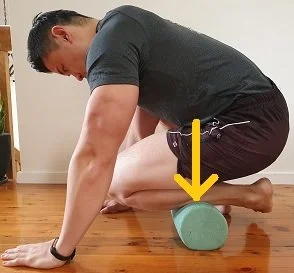
Instructions:
- Lay the front portion of your shin over a foam roller.
- Put as much pressure on the object as you are comfortable with.
- Be sure to cover the space completely.
- Keep going for a minute or two.
Exercise for knee clicking
STRETCHING
You can effectively reduce the stiffness that frequently accompanies arthritis and overuse by stretching the several muscle groups that support and move your knees. We would advise:
You’ll benefit from these stretches for the pops and clicks
- Develop the strength of your gluteal and quadriceps muscles.
- Improve the form of your squats.
- Instruct you to stretch before exerting significant force on your knees.
- Exercise: Downward Facing Dog for the calves and hamstrings.
- This pose works well for the inner thighs.
- Stretch for the glutes and hips.
- Quads Stretch.
STRENGTHENING
To guarantee that injured joint tissues receive the support they require, you should also work on strengthening your legs. We would advise:
- Work your glutes and quadriceps with squats.
- Clamshells for the inner thighs.
- Hamstring Curls.
- And Calf Raises.
Your muscles might get rather stiff if you spend most of the day sitting down or if you overwork them, so we must assist in enhancing muscular flexibility. It is advised that you purchase a foam roller. You can get a basic foam roller for less than $10.
Foam Rolling
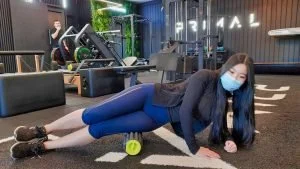
- Laying the foam roller down on the ground and pressing your front quadriceps into it.
- Make sure you don’t exceed the kneecap and try applying additional pressure to your arms to lessen the intensity of the discomfort.
- Find any tight places in the muscle by slowly moving up and down the entire length of it. Let it sit on the thigh regions for a short while to allow it to go deeper into the tissue.
Deep Squat Stretch
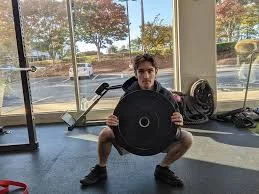
- Hold a weighted dumbbell, gym plate, or wall in front of your hands while squatting down. (assists in maintaining fall stability)
- Focus on your ankles, glutes, and core for a duration of thirty to sixty seconds to maintain your balance.
- Eventually, you want to be able to execute the deep squat position on your own.
Using a rope (or conditioning band, or dog leash) to stretch your quadriceps
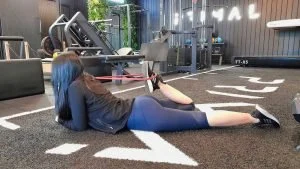
- Reclining on your stomach Take a rope and encircle your foot in it.
- Pull the rope over your shoulder so that your foot goes in the direction of your glutes.
- You’ll feel a stretch in your front quad that lasts for approximately 45 seconds.
Knee Flexion Gapping Stretch
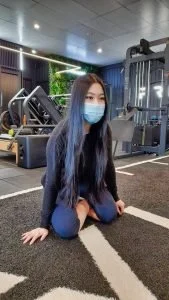
- Place one foot such that the ankle is behind the knee and remain there for a short while.
- Rock gently sideways and feel the muscles relax from the ankle, which will release tension and free up the tighter, constricted muscle areas.
- On each side, try doing this for two to five minutes.
Quadriceps
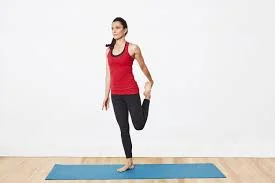
Instructions:
- Pull your ankle in the direction of your buttocks while standing.
- Stay up correctly and maintain your knees in line with each other.
- Put your tailbone down and push your hips forward a little.
- Your thigh should feel stretched in the front.
- For 30 seconds, hold.
Tensor Fasciae Latae

- Put yourself in a forward lunge.
- Keep your feet in alignment with each other.
- Now make a forward lunge.
- Place your tailbone beneath your body.
- Your hips should be leaned towards the back leg.
- Try to feel your hips’ outside and/or front stretches.
- For 30 seconds, hold.
Adductors
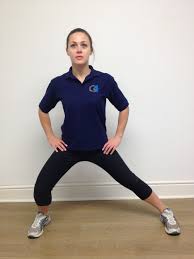
Instructions:
- Launch yourself to the side.
- Aim for a full stretch in the area of your inner thighs.
- For 30 seconds, hold.
Hamstring
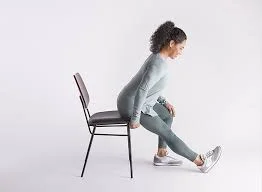
Instructions:
- Put your straightened leg in front of you on a block while you’re standing.
- Maintain a pointed foot.
- By hinging at the hips, flex forward.
- Maintain a straight back.
- Your goal should be to feel a stretch at the back of your leg.
- For 30 seconds, hold.
Calf
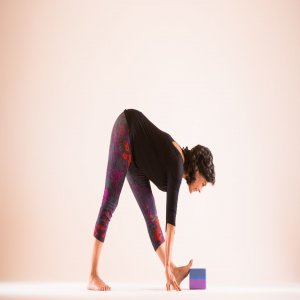
Instructions:
- Put your foot’s front side down on a brick.
- Step forward with your body while maintaining a straight leg.
- Try to feel your calf muscle stretching.
- For 30 seconds, hold.
Outer shin
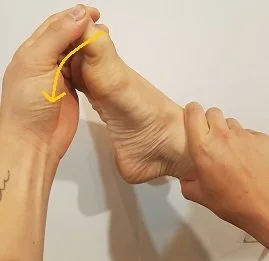
Instructions:
- Stack your ankle on top of the opposite knee while seated.
- Put one hand on the forefoot and the other on top of the ankle.
- Draw your forefoot in your direction while maintaining your ankle joint‘s anchor.
- (Don’t forget the toes!)
- Try to feel a stretch around the outside of your shin or ankle.
- For 30 seconds, hold.
Knee extension/flexion (VMO/inner thigh bias)
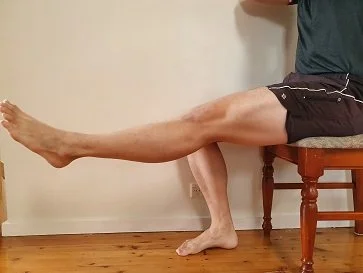
Instructions:
- Take a seat in a chair.
- Straighten your leg completely while maintaining a slightly externally rotated hip (toes pointed outside).
- It’s critical that you can sense your inner thigh muscles contracting.
- Keep your posture for five seconds.
- Extend your knee to the maximum extent feasible.
- Do this 20 times.
Wall plunge
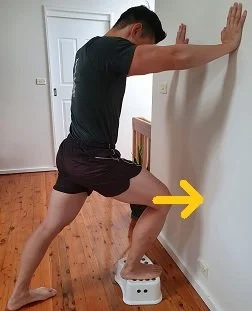
Instructions:
- Step on one of the steps.
- For support, place both of your hands on the wall in front of you.
- Maintain your knee alignment with your toes for the leg on the step throughout this exercise.
- Lean forward.
- Remember to maintain the majority of your body weight on your heels.
- As much as possible, move your knee forward without letting them click.
- Give as much help with your hands as is required.
- Make twenty repetitions.
Progression:
- Permit the knee to flex further forward.
- Step back from the support your arms are providing for you.
Step up with support
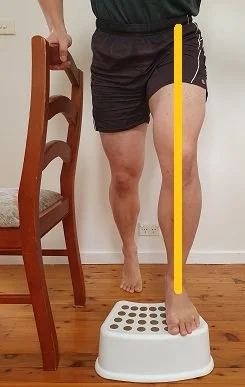
Instructions:
- Step on one of the steps.
- Grab onto the thing that is stationary in front of you.
- Throughout this exercise, keep the leg on the step’s knee in line with your toes.
- Use the towel to lift yourself as you complete a step-up.
- Ensure that the vehicle is passing past your heel.
- Reposition yourself to the beginning position slowly.
- Make twenty repetitions.
Progression:
- Cut back on how much arm support you apply.
- Take a step up.
Stand To Sit
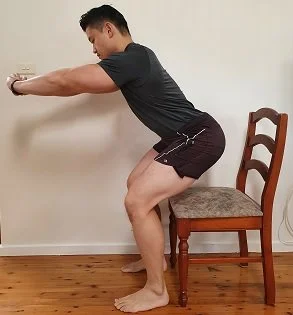
Instructions:
- Take a seat in a chair.
- Maintain a shoulder-width gap between your legs.
- During the entire exercise, keep your knees in line with your toes.
- Extend your knees inward.
- Take a stand.
- Ensure that the heel of the foot is driven through.
- Make twenty repetitions.
Progression:
- Grab the weights.
- Take a lower chair.
- Take your time with the exercise.
Knee-forward squat
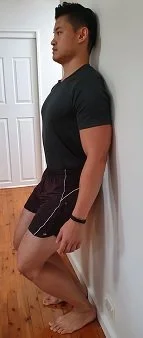
Instructions:
- Your back should be against the wall as you stand.
- Your feet should be shoulder-width apart.
- Throughout this exercise, keep your knees in line with your toes.
- Sliding down the wall, slowly bend your knees forward.
- You should only squat as low as it feels natural for you.
- Make twenty repetitions.
Should it be necessary, you can relieve some of the pressure on your knees by grasping onto a table for stability.
Over the next few weeks, repeat these stretches and assess your progress. In the next few days, you might notice that your muscles are more elastic or have a greater range of motion, which will improve your squat. Your body may be changing, so some meals can aid with inflammation if you are feeling mild soreness in your routine.
When to See a Doctor?
See an orthopedic specialist right away if you experience any of these symptoms to rule out a more serious issue. By doing this, more serious knee issues like ACL or femur damage may be avoided. They impact between 100,000 and 200,000 persons annually.
You should still have the popping in your knee checked out even if it doesn’t pain. In certain individuals, it might be a sign of an overuse injury. To protect the joint, you might need to lose weight, do knee-strengthening exercises, or get new shoes.
Treatments that directly and specifically target the exact ailment causing the abnormal popping or cracking inside the knee joint are the most successful. Knee joint inflammation can be effectively reduced, as can tendon issues and crepitus, with the help of rest and anti-inflammatory medications.
For most knee mechanical problems, arthroscopy is the preferred surgery. A camera and equipment are placed into the joint through tiny incisions to heal any damage.
When to Seek Medical Attention:
While knee clicking is often harmless, it’s important to consult a healthcare professional if you experience any of the following:
- Persistent Pain: If the clicking is accompanied by persistent pain or swelling.
- Locking or Catching: If the knee locks or catches during movement.
- Instability: Feeling like the knee is giving way or unstable.
- Decreased Range of Motion: If you notice a significant decrease in your knee’s range of motion.
- History of Injury: If you have a history of knee injury or if the clicking follows a traumatic event.
Conclusion
A painful click in the knee can be annoying. Patellofemoral syndrome, meniscus tears, knee osteoarthritis, ligament injuries, and soft tissue are the five main causes of this. Usually doesn’t need more investigation if it’s uncommon and unrelated to other symptoms. An evaluation is necessary if the condition is becoming more frequent and is accompanied by discomfort, edema, locking episodes, and restricted range of motion.
The clicking is an alert that something is wrong and needs to be fixed. Surgical solutions are offered by surgeons. There are several nonsurgical treatment options available to you from a physician experienced in interventional orthopedics. Finding the underlying reason is necessary for the treatment of this. The doctors of Centeno-Schultz Clinic are specialists in the field of care.PRP and stem cell injections are available as treatment alternatives.
This is a warning indicator if there is growing clicking in the knee and it is accompanied by discomfort, edema, or restricted range of motion. Take immediate action before the issue worsens and there are no more options. Arrange a telemedicine consultation with a board-certified medical professional who can assess your medical history and studies, and recommend the most effective nonsurgical course of therapy. Your body is alerting you to pay attention to it!
FAQs
What does a clicking knee mean?
Age-related cartilage displacement is referred described as “clicking the knee.”There will be popping and clicking noises as a result of the cartilage’s jagged edges being stuck between the joint surfaces. The typical movements that cannot be handled on their own are resisted by clicking the knee.
How can I stop the clicking in my knee?
To cease kicking your knees, you ought to:
Put on appropriate shoes.
Take up the proper sleeping position.
Make use of vitamins and supplements.
Apply compression therapy.
A suitable warm-up.
Will clicking knee go away?
It is easy to handle knee clicking and cracking once one understands what is causing it initially. Generally speaking, clicking your knees shouldn’t cause any major issues. Additionally, there is no specific treatment required for those who have knee clicking. It could be a good idea to contact a doctor if any additional severe symptoms are noticed.
What makes my knee click when I bend it?
When bending, the clicking of the knee is perceptible. The reason for this is that synovial fluid is present in every joint in our body. Synovial fluid facilitates the easy sliding of bones over one another. Air bubbles can occasionally occur in the synovial fluid. That’s why the little air bubbles in your knees pop, clicking, and crackling every time you bend them.
Does arthritis cause a click in the knee?
Yes, there are numerous signs that a person has knee arthritis.
Knee buckling.
Having trouble walking.
Skin redness.
Creaking, snapping, grinding, clicking noises.
Warm skin.
It sticks or locks when you try to move your knee.
Joint stiffness.
Is walking good for arthritis in the knee?
Walking is an excellent treatment for those with knee arthritis. Walking can increase knee range of motion and keep them from getting unduly stiff and tight since it is a gentle, easy exercise that does not put undue load on the joints.
Why do joints start clicking?
Joints might pop and snap at random times. The sound you hear is the result of tightly stretched ligaments snapping when they slide off one bone surface onto another, as well as air bubbles in the synovial fluid, which surrounds and lubricates your joints.
What does it mean when your knee clicks?
Your meniscus or articular cartilage may have been injured, as well as your anterior cruciate ligament, posterior cruciate ligament, or medial collateral ligament. Generally speaking, if you have knee clicking and catching but no discomfort or swelling, it’s probably normal.
Does a meniscus tear cause clicking?
Twisting the knee while bearing weight is a common cause of a torn meniscus. A torn meniscus results in knee pain, locking or clicking, and weakening.
Can knee clicking be cured?
Occasionally, your knee may feel like it’s “catching” due to loose or damaged cartilage. A straightforward treatment to remove a loose piece or trim ragged edges can repair loose or damaged cartilage that interferes with normal motion and may not be able to heal on its own.
Should I be worried if my knee clicks?
Knee clicking is usually not a cause for concern. However, if the clicks are accompanied by pain or other inflammatory symptoms like swelling and redness, there may be an underlying medical issue. If this is the case for you, get medical attention, buy a quality brace, and begin strengthening and extending your knee’s range of motion.
Do healthy knees click?
Knee clicks are typical; your knees are made of several moving parts that glide and move next to one another as you bend and straighten them, as you would when climbing or descending stairs.
Why is my knee clicking but no pain?
A painful click in the knee can be annoying. Patellofemoral syndrome, meniscus tears, knee osteoarthritis, ligament injuries, and soft tissue are the five main causes of this. Generally does not merit additional assessment if rare and unrelated to other symptoms.
How can I stop my joints from clicking?
Physical activities that require energy expenditure include walking, cycling, and level-ground jogging.
Strength training or weight lifting.
Stretching.
Neuromuscular exercise includes resistance training, speed training, core building, and plyometrics.
Balance training.
Aquatic exercise such as swimming.
Is clicking knee arthritis?
A creaking, clicking, grinding, or snapping sound (known as crepitus) is one of the several indications and symptoms of arthritis in the knee. walking is difficult. The degree of joint soreness varies with the weather.
Will a knee brace help with clicking?
With the use of a knee brace and physical therapy, knee popping can be prevented and the likelihood of re-injury decreased.
Is it OK to click joints?
Joints that crack without pain are often not dangerous. Nonetheless, common sense typically suggests that purposeful and repetitive joint cracking may be uncomfortable both socially and physiologically, if it causes pain.
How do you heal a clicking knee?
As strength returns to the knee joint, knee clicking typically disappears. Not every rupture of cartilage and ligament requires surgery. Knee support and physical therapy may be recommended to reduce knee clicking if surgery is not an option for you.
References
- Knee Clicking: What Causes It, When to Get Worried, and More. (2022, April 5). Centeno-Schultz Clinic. https://centenoschultz.com/symptom/knee-clicking/.
- S. (2023, March 10). What Causes Your Knees to Click and Is It Safe to Distress? – Read & Learn More. Southgate physio. https://www.southgatephysio.co.uk/why-do-your-knees-click-and-should-you-worry/.
- Knee Clicking: What Causes It, When to Get Worried, and More. (2022, April 5). Centeno-Schultz Clinic. https://centenoschultz.com/symptom/knee-clicking/.
- A. (2021, November 3). What makes my knee click, and should I be concerned? The sports medicine and orthopedic center of Plano. Various factors can cause knee clicks.
- Causes of Knee Clicking and the Best Treatments for It in 2024. (2024, March 23). ProHealth Prolotherapy Clinic. https://prohealthclinic.co.uk/blog/knee-clicking/.
- Australia, B. (n.d.). Bauerfeind. Bauerfeind Australia. https://www.bauerfeind.com.au/blogs/news/knee-clicking-should-you-be-worried.
- Clicking in the Knees. (n.d.). https://www.donjoystore.com/injury-info-center/knee-injury-guide/clicking-knees.
- Physiotherapy, P., & Physiotherapy, P. (2021, August 26). Primal Physiotherapy: 4 Simple Exercises to Correct Knee Clicks During Squats. Early Physiotherapy – Move Without Limits. https://primalphysiotherapy.com.au/blog/knee-click-stretches/.
- M. (2023, March 22). Exercises for a Clicking Knee. Posture Direct. https://www.posturedirect.com/clicking-knee/.
- Image -www.theprolotherapyclinic.com%2Fknee-clicking%2F&psig=AOvVaw2nskK7QAJ-xphIe0ln5aku&ust=1712372838665000&source=images

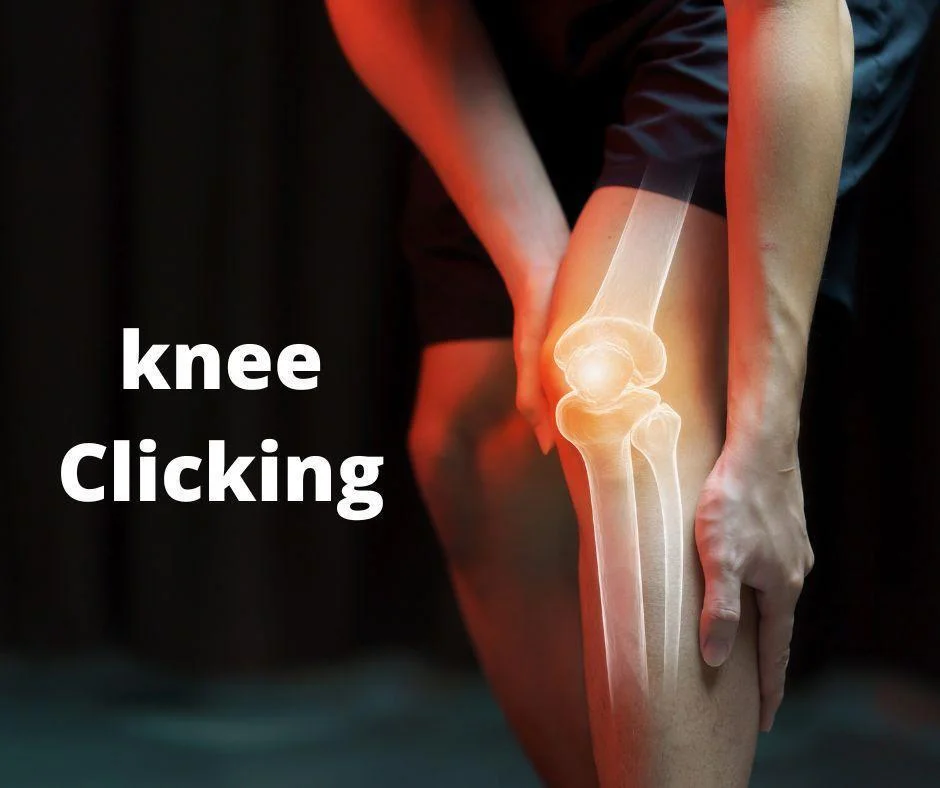
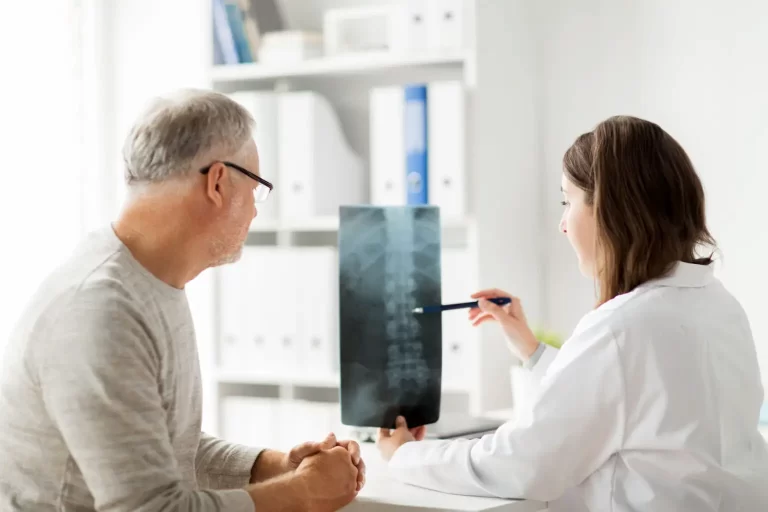
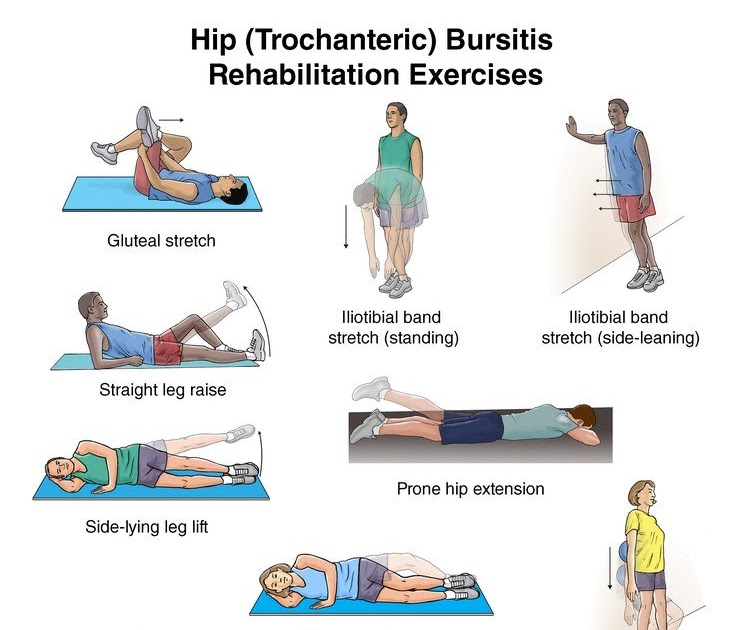
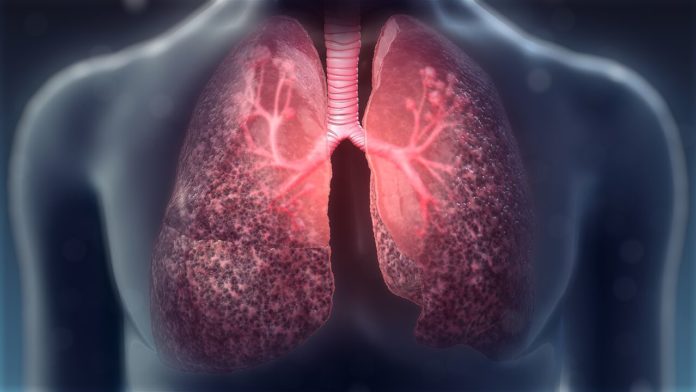
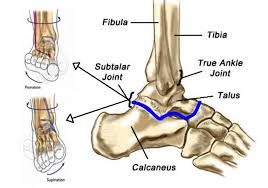
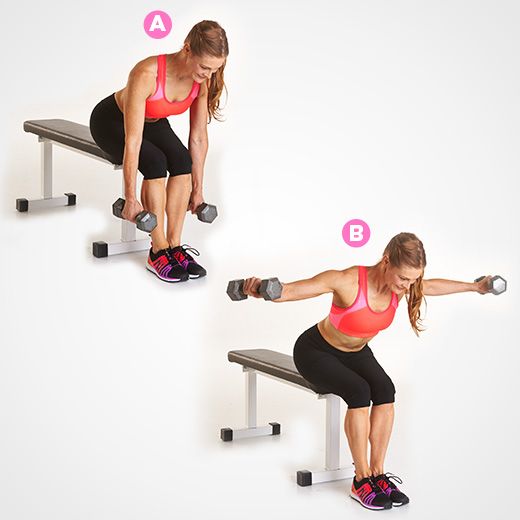
One Comment